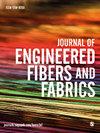Fabrication and properties of far-infrared functional bandage
IF 2.3
4区 工程技术
Q1 MATERIALS SCIENCE, TEXTILES
引用次数: 0
Abstract
In order to develop far-infrared functional bandage products with excellent performance, tourmaline powder was selected as the far-infrared radiation material and the far-infrared functional finishing of polyester fabric was carried out by the dip-rolling process. Taking the radiation temperature rise value as the index to explore the optimal process conditions for the far-infrared performance, then the microstructure, mechanical properties, comfort performance, and far-infrared radiation performance of the far-infrared bandage were further investigated, respectively. Based on the results, the optimum process conditions for heating bandage have been proposed (tourmaline powder mass fraction, 5%; polyacrylate mass fraction, 25%; impregnation temperature, 40°; impregnation time, 15 min, baking temperature, 140° and baking time, 1 min). After being treated, the mechanical properties of the bandage enhanced, the air permeability decreased, and the moisture permeability increased significantly, indicating its comfort and is suitable for practical application. It was measured that the far-infrared ray emission value of the far-infrared functional bandage was 0.89, which was greater than the 0.80 required by CAS 115-2005 “Health Functional Textiles” standard, proving that the attachment of tourmaline made the far-infrared radiation performance of the bandage significantly improved. These attractive features of the far-infrared functional bandages promise them great potential in far-infrared health care applications.远红外功能绷带的制备与性能
为了开发性能优异的远红外功能绷带产品,选择电气石粉作为远红外辐射材料,采用浸轧工艺对涤纶织物进行了远红外功能整理。以辐射温升值为指标,探索远红外性能的最佳工艺条件,进而分别对远红外绷带的微观结构、力学性能、舒适性能和远红外辐射性能进行了深入研究。在此基础上,提出了加热绷带的最佳工艺条件(电气石粉末质量分数为5%;聚丙烯酸酯质量分数为25%;浸渍温度为40°;浸渍时间为15 min,烘烤温度140°,烘烤时间1 分钟)。经过处理后,绷带的力学性能增强,透气性降低,透湿性显著提高,舒适性良好,适合实际应用。经测定,远红外功能绷带的远红外线发射值为0.89,大于CAS 115-2005《保健功能纺织品》标准要求的0.80,证明电气石的附着使绷带的远红外辐射性能显著提高。远红外功能绷带的这些吸引人的特性使其在远红外医疗保健应用中具有巨大的潜力。
本文章由计算机程序翻译,如有差异,请以英文原文为准。
求助全文
约1分钟内获得全文
求助全文
来源期刊

Journal of Engineered Fibers and Fabrics
工程技术-材料科学:纺织
CiteScore
5.00
自引率
6.90%
发文量
41
审稿时长
4 months
期刊介绍:
Journal of Engineered Fibers and Fabrics is a peer-reviewed, open access journal which aims to facilitate the rapid and wide dissemination of research in the engineering of textiles, clothing and fiber based structures.
 求助内容:
求助内容: 应助结果提醒方式:
应助结果提醒方式:


